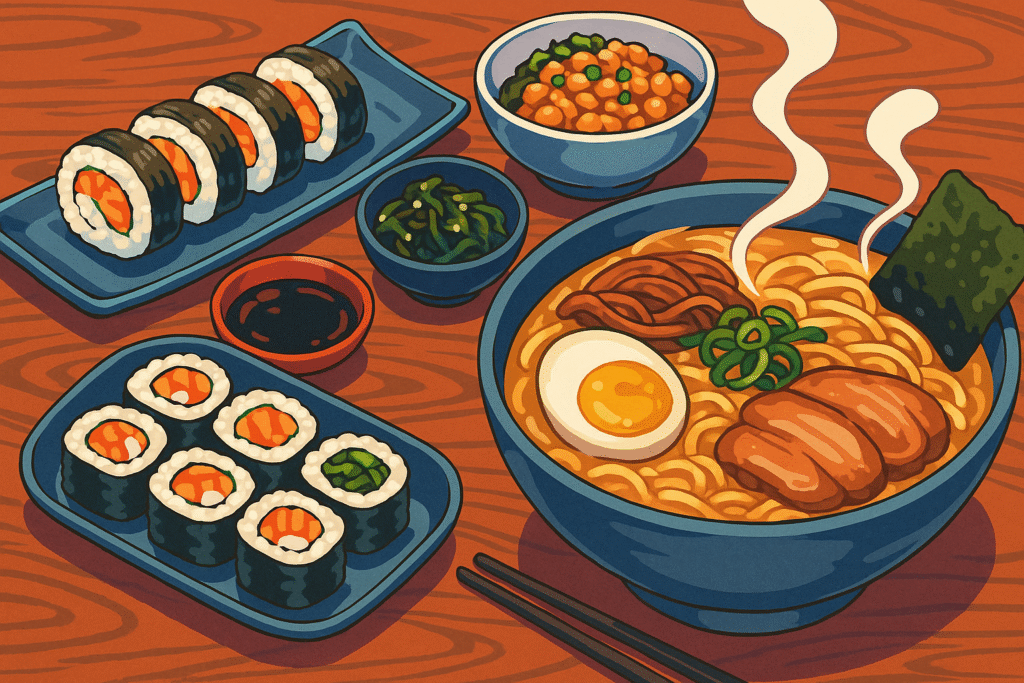Japanese Cuisine

Japanese cuisine, known as “washoku,” is a delicate dance of balance, presentation, and seasonality. Rooted in centuries of tradition, it comes from Japan’s varied landscape — an archipelago stretching from icy Hokkaido to subtropical Okinawa. Japanese food is celebrated for its precise simplicity, clean flavors, and a reverence for the natural essence of each ingredient. Whether it’s the briny pop of fresh uni, the ethereal umami of dashi broth, or pickled vegetables with a sharp, tangy kick, each dish tells a story of region and rhythm. Staples like rice, soy, fresh seafood, tofu, and seasonal vegetables are combined with techniques such as grilling, steaming, fermenting, and delicate frying—all elevating everyday ingredients into memorable bites. What sets Japanese cuisine apart is not just the taste, but the visual artistry and mindfulness behind every meal.
The History of Japanese Cuisine
Japanese cuisine traces its roots to centuries of agricultural traditions, spiritual beliefs, and interactions with neighboring cultures. The earliest Japanese diets centered around rice, wild plants, and fish. Buddhism’s arrival in the 6th century prompted widespread vegetarianism, which profoundly shaped the country’s foodways — think tofu, yuba, and intricate vegetable preparations. Over time, influences from China introduced ingredients like miso and soy sauce, while contact with the Portuguese in the 16th century brought tempura and castella cake. The Edo period (1603–1868) solidified culinary codes: sushi, ramen, and katsudon flourished in bustling cities, while kaiseki, a seasonal multi-course meal, became an art form in Kyoto. Today, Japan’s food culture is a global force. Chefs worldwide celebrate Japanese flavors, from the purity of sashimi to the careful precision of wagashi sweets, and UNESCO has recognized washoku as an Intangible Cultural Heritage.
Key Ingredients in Japanese Cuisine
Top Dishes in the Region
Top Food Destinations in the Region
Tokyo
Japan’s capital pulses with thousands of dining establishments, from tiny standing noodle bars to Michelin-starred temples of gastronomy. Tsukiji Outer Market is where locals and chefs hunt for pristine seafood, while neighborhoods like Shibuya and Shinjuku buzz with izakayas and ramen joints. Don’t miss sushi at counter-style sushiya or street snacks like taiyaki and takoyaki.
Osaka
Known as the nation’s kitchen, Osaka is legendary for its hearty, comforting street food. Dotonbori lights up with okonomiyaki (savory pancakes), kushikatsu (deep-fried skewers), and takoyaki (octopus balls). The locals’ love for kuidaore—“eat until you drop”—makes this city a joy for adventurous eaters.
Kyoto
The former imperial capital is the cradle of kaiseki, the refined, seasonal tasting menu. Here, meals are experiences, with artful presentations and subtle flavors. Kyoto is also renowned for yudofu (delicate tofu hot pot), matcha sweets, and elaborate Buddhist temple cuisine known as shōjin ryōri.
Sapporo
Located in Hokkaido, Sapporo is the place for wintertime comfort: piping-hot bowls of miso ramen, buttery seafood rice bowls, and sweet corn. Don’t miss the city’s fresh crab, Hokkaido dairy products, and the renowned Sapporo beer scene.
Fukuoka
On Japan’s southern island of Kyushu, Fukuoka is ramen heaven—home of tonkotsu ramen, with its creamy pork-bone broth, thin noodles, and array of toppings. Street-side yatai stalls dish out yakitori (grilled chicken skewers), oden, and regional delicacies like mentaiko (spicy cod roe).
Our favorite content showcasing Japanese Cuisine
No content has been added yet.
FAQs About Japanese Cuisine
What are the must-try traditional Japanese dishes?
Sushi, sashimi, ramen, tempura, and yakitori are must-tries. Regional specialties like Kyoto’s kaiseki, Osaka’s takoyaki, and Hokkaido’s seafood donburi offer an even deeper dive into local food traditions.
How does seasonality influence Japanese food?
Seasonality is woven into the soul of Japanese cooking. Menus shift throughout the year to showcase the freshest ingredients, whether it’s spring’s bamboo shoots, summer’s eel, autumn mushrooms, or winter daikon and seafood.
Is Japanese cuisine vegetarian-friendly?
Thanks to Buddhist influences and a long history of vegetable-forward cooking, Japanese cuisine is rich in vegetarian offerings: zaru soba (cold buckwheat noodles), yudofu, shojin ryori, and a wide array of pickles, seaweed, and tofu-based dishes. However, many broths use fish, so always check with restaurants and cooks.
What essential pantry items define Japanese cooking?
Key staples include soy sauce, miso, mirin, rice vinegar, dashi (broth), kombu (seaweed), katsuobushi (bonito flakes), sake, rice, and shoyu. Stocking these basics unlocks the flavors of countless Japanese recipes.
Why is presentation so important in Japanese cuisine?
Japanese meals are a feast for both the palate and the eyes. The philosophy of “ichi-go ichi-e” (treasuring the moment) means careful arrangement, seasonal garnishes, and thoughtful plateware—all designed to heighten the dining experience and celebrate the beauty of nature.